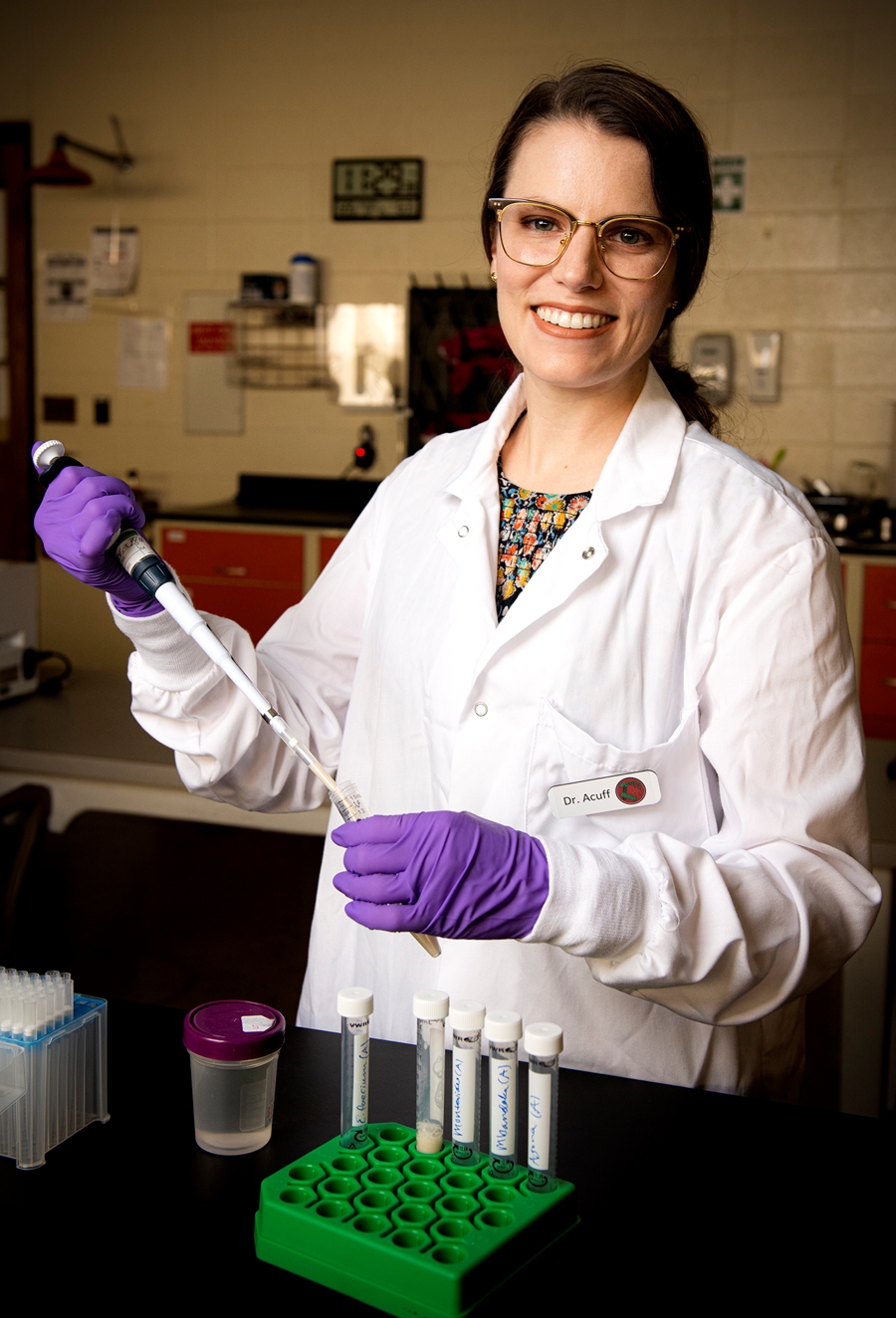
Helping keep dry foods safe for consumption is the goal of an Arkansas Agricultural Experiment Station researcher who was recently awarded a $200,000 grant from the U.S. Department of Agriculture National Institute of Food and Agriculture.
Jennifer Acuff, assistant professor in food safety and microbiology with the U of A System Division of Agriculture, received the grant to learn more about how much moisture is required to allow bacterial survival in low-moisture foods. The research will help develop foundational knowledge on how bacteria persist in low-moisture food processing environments.
"We don't really know how much water or nutrients are required to sustain these contaminating populations, but we know they can persist in the dry environment for a long time," Acuff said. "Our goals for the grant are to develop protocols for a laboratory that simulate these 'persistent populations' so that we can study how to prevent their formation or mitigate the risks once they do form in a low-moisture food processing environment."
Results from her two-year research grant will provide information and recommendations to processors for improving low-moisture food safety.
The Centers for Disease Control and Prevention and the U.S. Food and Drug Administration have reported several incidences of foodborne illness outbreaks from low-moisture foods. The most recent has been Cronobacter sakazakii infections in a powdered infant formula this year. The CDC stated that the Cronobacter infections may have contributed to the cause of death for two patients.
"Many low-moisture foods are also considered ready-to-eat, so this puts consumers at a particular risk because they are not expecting the food to be unsafe and will not be doing anything to it that could kill pathogens, such as cooking," Acuff said.
Nuts, dried fruits, powdered drinks, dry pet food, seasonings and some candy and snack foods are just a few examples of low-moisture foods that could benefit from the research.
Hundreds of illnesses, sometimes resulting in hospitalizations, have been reported from consuming contaminated low-moisture foods infected with Salmonella and Shiga toxin-producing Escherichia coli (E. coli). Listeria monocytogenes been the cause of recalls, according to reports from the CDC and FDA. In recent years, the agency has reported foodborne illnesses from pathogens in several brands of baking flour, a soy-nut butter, a dried coconut product and a cake mix, among others.
Acuff said cleaning and sanitation of low-moisture food processing facilities are difficult because of the need to limit water and moisture exposure. When water is introduced to a low-moisture foods processing area for cleaning, Acuff said it could either introduce foodborne pathogens or sustain the survival of pathogens.
Dried food producers and low-moisture food processors still seek strategies and methods to keep their manufacturing environments clean and sanitary without water, Acuff added.
The research is designed to gather data that will allow collaborative research in the future on cleaning, sanitizing and processing in a low-moisture food environment.
As part of the study, Acuff will examine how cross-contamination can occur from the persistent bacterial populations to non-contaminated product in the presence of limited water and nutrients. Also, Acuff will identify a suitable surrogate microorganism that is nonpathogenic but can mimic the behavior of a pathogen, so that the laboratory results can be validated in food processing plants without introducing a pathogen to the environment.
Acuff joined the U of A System Division of Agriculture and Dale Bumpers College of Agricultural, Food and Life Sciences in 2020 after earning her doctorate in food safety and microbiology from Virginia Tech University. She has a bachelor's degree in biology from Abilene Christian University in Texas and a master's in food microbiology from Kansas State University. Her research focuses on reducing pathogens from foods at the post-harvest level through prevention and intervention.
Acuff's teaching appointment allows her to teach and mentor undergraduate and graduate students. She also has a cooperative extension service appointment through which she engages with the community on food safety issues.
Acuff said her lab is focused on the development and application of interventions and practices for the food industry to improve low-moisture food safety. Some of her work focuses on the thermal inactivation of Salmonella from dairy milk powders, the decontamination of pecans contaminated with Shiga toxin-producing E. coli and inactivation of pathogens on spices.
To learn more about Division of Agriculture research, visit the Arkansas Agricultural Experiment Station website: aaes.uada.edu. Follow us on Twitter at @ArkAgResearch.
To learn about Extension Programs in Arkansas, contact your local Cooperative Extension Service agent or visit uaex.uada.edu. Follow us on Twitter at @AR_Extension.
To learn more about the Division of Agriculture, visit https://uada.edu/. Follow us on Twitter at @AgInArk.
About the Division of Agriculture: The University of Arkansas System Division of Agriculture's mission is to strengthen agriculture, communities, and families by connecting trusted research to the adoption of best practices. Through the Agricultural Experiment Station and the Cooperative Extension Service, the Division of Agriculture conducts research and extension work within the nation's historic land grant education system. The Division of Agriculture is one of 20 entities within the University of Arkansas System. It has offices in all 75 counties in Arkansas and faculty on five system campuses. The University of Arkansas System Division of Agriculture offers all its Extension and Research programs and services without regard to race, color, sex, gender identity, sexual orientation, national origin, religion, age, disability, marital or veteran status, genetic information, or any other legally protected status, and is an Affirmative Action/Equal Opportunity Employer.
Topics
Contacts
John Lovett, project/program specialist
Agricultural Communication Services
479-763-5929, jl119@uark.edu